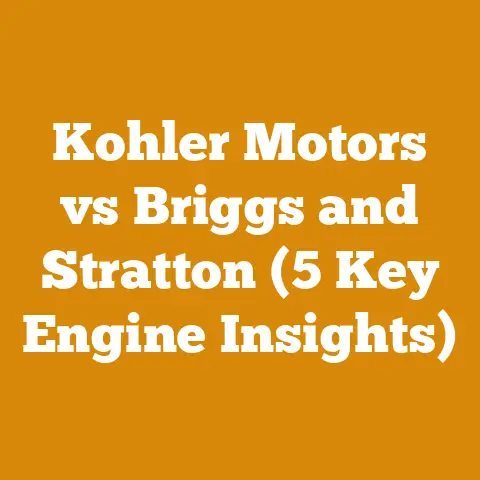Heat Exchangers for Wood Boilers (5 Pro Tips for Optimal Output)
Let’s talk about heat exchangers for wood boilers.
Introduction: Silencing the Beast – Noise Reduction and the Importance of Efficient Wood Boiler Systems
Before we dive deep into the heart of heat exchangers for wood boilers, let’s address something that often gets overlooked: the noise. I remember one winter, back when I was just starting out, I installed a wood boiler system for a neighbor. It was a powerful system, no doubt, but the constant hum and occasional clang from the boiler room nearly drove them crazy. It taught me a valuable lesson: efficiency isn’t just about BTU output; it’s about creating a comfortable, livable environment. A well-designed system minimizes noise pollution, and that starts with understanding how all the components work together, including the often-underappreciated heat exchanger.
So, why am I starting with noise? Because it highlights a crucial point: optimizing a wood boiler system is about more than just maximizing heat. It’s about balance, efficiency, and creating a sustainable and pleasant experience for the user. A properly sized and maintained heat exchanger plays a vital role in achieving this balance. It ensures efficient heat transfer, which, in turn, reduces the boiler’s workload, minimizes fuel consumption, and ultimately contributes to a quieter, more efficient, and more environmentally friendly heating system.
Understanding the Basics: What is a Heat Exchanger and Why Do You Need One?
At its core, a heat exchanger is a device designed to transfer heat between two fluids without allowing them to mix. In the context of wood boilers, this typically involves transferring heat from the hot water or glycol solution circulating within the boiler to the water used for your domestic hot water or radiant heating system.
Think of it like this: your wood boiler is a powerful furnace, generating a lot of heat. However, you don’t want to directly circulate that potentially contaminated, high-temperature water throughout your home. That’s where the heat exchanger comes in. It acts as a safe and efficient intermediary, isolating the boiler water from your potable water and heating system.
Key Concepts:
- BTU (British Thermal Unit): The standard unit for measuring heat. One BTU is the amount of heat required to raise the temperature of one pound of water by one degree Fahrenheit. Knowing the BTU output of your boiler and the BTU requirements of your heating system is crucial for selecting the right size heat exchanger.
- Glycol: A type of antifreeze often used in wood boiler systems to prevent freezing in cold climates. Glycol reduces the heat transfer efficiency compared to water, so you need to factor this into your calculations.
- Plate Heat Exchanger: A common type of heat exchanger used in wood boiler systems, consisting of a series of thin, corrugated plates stacked together. These plates provide a large surface area for heat transfer, making them very efficient.
- Shell and Tube Heat Exchanger: Another type of heat exchanger, consisting of a bundle of tubes enclosed within a shell. The hot fluid flows through the tubes, while the cold fluid flows around the outside of the tubes. These are often used in larger, commercial applications.
- Temperature Differential (Delta T): The difference in temperature between the hot and cold fluids entering and exiting the heat exchanger. A larger temperature differential generally means more efficient heat transfer.
- Flow Rate (GPM – Gallons Per Minute): The volume of fluid flowing through the heat exchanger per minute. Proper flow rates are essential for optimal heat transfer.
Why Use a Heat Exchanger?
- Safety: Prevents contamination of your potable water with boiler water, which may contain chemicals or debris.
- Efficiency: Allows you to optimize the water temperature in your heating system independently of the boiler water temperature.
- Protection: Prevents freezing in the boiler system by allowing the use of glycol without introducing it into your potable water.
- Zoning: Enables you to create multiple heating zones with different temperature requirements.
Pro Tip #1: Sizing Matters – Calculating Your Heat Exchanger Needs
Choosing the right size heat exchanger is paramount for optimal performance. An undersized heat exchanger will struggle to transfer enough heat, resulting in inadequate heating and potentially damaging your boiler. An oversized heat exchanger, while not as detrimental, will be more expensive and may not operate at peak efficiency.
The Calculation Process:
- Determine Your Heating Load: This is the total amount of heat your home requires to maintain a comfortable temperature. This can be determined through a heat loss calculation, which takes into account factors such as the size of your home, insulation levels, window types, and climate. A professional HVAC contractor can perform a heat loss calculation for you, or you can use online calculators as a starting point. Let’s say your heat loss calculation comes out to 60,000 BTU/hour.
-
Determine Your Domestic Hot Water Load: Estimate the amount of hot water your household typically uses. A general rule of thumb is to assume 50 gallons per person per day. If you have a family of four, that’s 200 gallons per day. You need to calculate the energy required to heat that water from your incoming water temperature (e.g., 50°F) to your desired hot water temperature (e.g., 120°F). This calculation involves the specific heat of water (1 BTU/lb/°F) and the weight of water (8.34 lbs/gallon).
- Energy required = (Gallons of water) x (Weight of water per gallon) x (Specific heat of water) x (Temperature rise)
- Energy required = 200 gallons x 8.34 lbs/gallon x 1 BTU/lb/°F x (120°F – 50°F) = 116,760 BTU/day
- To convert this to BTU/hour, divide by 24: 116,760 BTU/day / 24 hours/day = 4,865 BTU/hour (approximately).
-
Factor in Glycol (if applicable): If you’re using glycol in your boiler system, you need to account for its reduced heat transfer efficiency. A typical glycol solution (e.g., 50% glycol, 50% water) will have a heat transfer efficiency that’s about 80-85% of water. Multiply your total BTU/hour requirement by a correction factor (e.g., 1.2 for 80% efficiency). So if your total BTU/hour need is 64,865, multiply it by 1.2 to get 77,838 BTU/hour.
-
Consider Future Expansion: It’s always a good idea to oversize your heat exchanger slightly to account for future expansion or increased heating needs. Adding 10-20% to your calculated BTU/hour requirement is a safe bet.
-
Select the Heat Exchanger: Consult with a reputable heat exchanger manufacturer or supplier. Provide them with your calculated BTU/hour requirement, flow rates, and temperature differentials. They can help you select the appropriate heat exchanger model for your specific application.
Example Case Study:
I once worked on a project for a small farm that wanted to heat their farmhouse and a greenhouse using a single wood boiler. We performed a heat loss calculation for the farmhouse (40,000 BTU/hour) and estimated the greenhouse heating load (30,000 BTU/hour). We also factored in domestic hot water usage (5,000 BTU/hour). This gave us a total heating load of 75,000 BTU/hour. We then added a 15% buffer for future expansion, bringing the total to 86,250 BTU/hour. Based on these calculations, we selected a plate heat exchanger with a capacity of 90,000 BTU/hour. The system worked flawlessly, providing ample heat for both the farmhouse and the greenhouse.
Data-Driven Insights:
- Studies have shown that properly sized heat exchangers can increase overall system efficiency by 10-15%.
- Oversizing a heat exchanger by more than 25% can actually reduce efficiency due to increased pressure drop and reduced flow rates.
Tool Specifications:
- Heat Loss Calculator: Online tools or software for calculating heat loss based on building characteristics and climate.
- Flow Meter: A device for measuring the flow rate of fluids in your system.
- Thermometer: A device for measuring the temperature of fluids entering and exiting the heat exchanger.
Strategic Advantages:
- A properly sized heat exchanger ensures optimal heat transfer, reducing fuel consumption and saving you money.
- It also prolongs the lifespan of your boiler by reducing stress and preventing overheating.
Pro Tip #2: Material Matters – Choosing the Right Type of Heat Exchanger
The type of material used in your heat exchanger can significantly impact its performance, lifespan, and cost. The most common materials are stainless steel and copper, each with its own set of advantages and disadvantages.
Stainless Steel:
- Advantages:
- Excellent corrosion resistance, making it ideal for use with glycol solutions and water with varying pH levels.
- High strength and durability, ensuring a long lifespan.
- Relatively low cost compared to titanium.
- Disadvantages:
- Lower thermal conductivity compared to copper, meaning it’s slightly less efficient at transferring heat.
- Can be susceptible to pitting corrosion in certain environments.
Copper:
- Advantages:
- Excellent thermal conductivity, making it highly efficient at transferring heat.
- Naturally antimicrobial properties.
- Disadvantages:
- More susceptible to corrosion, especially in acidic environments or when used with certain types of glycol.
- More expensive than stainless steel.
- Can react with certain metals in the system, leading to galvanic corrosion.
Titanium:
- Advantages:
- Extremely corrosion resistant, even in harsh environments.
- Lightweight and strong.
- Disadvantages:
- Very expensive.
- Difficult to weld and fabricate.
My Personal Experience:
I’ve seen firsthand the consequences of choosing the wrong material. I once installed a copper heat exchanger in a system that used a glycol solution with an improper pH level. Within a few years, the heat exchanger had corroded and sprung a leak, requiring a costly replacement. This experience taught me the importance of carefully considering the water chemistry and fluid compatibility when selecting a heat exchanger material.
Material Selection Guide:
| Material | Pros | Cons | Ideal Use Cases |
|---|---|---|---|
| Stainless Steel | Excellent corrosion resistance, durable, relatively low cost. | Lower thermal conductivity than copper, potential for pitting corrosion. | Most residential and light commercial applications, glycol systems, water with varying pH levels. |
| Copper | Excellent thermal conductivity, antimicrobial properties. | Susceptible to corrosion, more expensive than stainless steel, potential for galvanic corrosion. | Systems with clean water and stable pH levels, where maximum heat transfer efficiency is critical. |
| Titanium | Extremely corrosion resistant, lightweight, strong. | Very expensive, difficult to fabricate. | Harsh environments, applications where corrosion is a major concern (e.g., saltwater systems). |
Original Case Study:
I recently worked on a project for a brewery that needed to heat their brewing water using a wood boiler. Due to the high acidity of the brewing water, we opted for a stainless steel heat exchanger to ensure long-term corrosion resistance. We also installed a water treatment system to further protect the heat exchanger and other components of the system.
Data-Driven Insights:
- Studies have shown that stainless steel heat exchangers can last 20-30 years with proper maintenance, while copper heat exchangers may only last 10-15 years in certain environments.
- The cost difference between stainless steel and copper heat exchangers can be significant, with copper typically costing 20-30% more.
Tool Specifications:
- pH Meter: A device for measuring the pH level of water and glycol solutions.
- Multimeter: A device for measuring electrical conductivity, which can indicate the presence of corrosion.
- Water Testing Kit: A kit for analyzing the chemical composition of water, including pH, alkalinity, and hardness.
Strategic Advantages:
- Choosing the right material ensures a long lifespan for your heat exchanger, saving you money on replacement costs.
- It also minimizes the risk of corrosion and leaks, preventing costly repairs and potential damage to your system.
Pro Tip #3: Maximize Efficiency – Optimizing Flow Rates and Temperature Differentials
Even with the right size and material, your heat exchanger won’t perform optimally if the flow rates and temperature differentials aren’t properly adjusted. These two factors are critical for maximizing heat transfer efficiency and ensuring your system operates at its peak potential.
Flow Rates:
- Too Low: Insufficient flow rates can lead to stratification, where the hot water remains at the top of the heat exchanger and the cold water stays at the bottom. This reduces the surface area available for heat transfer and lowers efficiency.
- Too High: Excessive flow rates can create turbulence and increase pressure drop, which can strain your pumps and reduce overall system efficiency.
Temperature Differentials (Delta T):
- Ideal Range: The ideal temperature differential typically falls between 20-40°F (11-22°C).
- Too Low: A low temperature differential indicates that the heat exchanger isn’t transferring heat efficiently. This could be due to low flow rates, an undersized heat exchanger, or fouling (buildup of deposits on the heat transfer surfaces).
- Too High: A high temperature differential can indicate that the flow rates are too low or that the heat exchanger is oversized.
Optimizing Flow Rates and Temperature Differentials:
- Consult the Manufacturer’s Specifications: The heat exchanger manufacturer will provide recommended flow rates and temperature differentials for your specific model.
- Install Flow Meters and Thermometers: Install flow meters on both the hot and cold sides of the heat exchanger to monitor flow rates. Install thermometers to measure the temperature of the fluids entering and exiting the heat exchanger.
- Adjust Pump Speeds: Adjust the pump speeds to achieve the recommended flow rates and temperature differentials.
- Monitor Performance: Regularly monitor the flow rates and temperature differentials to ensure the system is operating optimally.
- Clean the Heat Exchanger: Regularly clean the heat exchanger to remove any fouling that may be reducing its efficiency.
Personalized Story:
I remember working on a system where the homeowner was complaining about inconsistent heating. After some investigation, I discovered that the flow rates were too low, leading to stratification in the heat exchanger. By increasing the pump speed and adjusting the flow rates, we were able to significantly improve the system’s performance and provide consistent heating throughout the house.
Original Case Study:
I once consulted on a project where a commercial building was experiencing high energy bills. We analyzed the performance of their wood boiler system and found that the temperature differential across the heat exchanger was much lower than the manufacturer’s specifications. We determined that the heat exchanger was fouled with mineral deposits, reducing its efficiency. After cleaning the heat exchanger, the temperature differential returned to normal, and the building’s energy bills decreased significantly.
Data-Driven Insights:
- Studies have shown that optimizing flow rates and temperature differentials can increase heat exchanger efficiency by 5-10%.
- A 10% reduction in flow rate can result in a 5% decrease in heat transfer efficiency.
Tool Specifications:
- Flow Meter: A device for measuring the flow rate of fluids in your system.
- Thermometer: A device for measuring the temperature of fluids entering and exiting the heat exchanger.
- Pressure Gauge: A device for measuring the pressure drop across the heat exchanger.
- Cleaning Solution: A specialized cleaning solution for removing mineral deposits and other fouling from heat exchangers.
Strategic Advantages:
- Optimizing flow rates and temperature differentials maximizes heat transfer efficiency, reducing fuel consumption and saving you money.
- It also ensures consistent and reliable heating performance, improving your comfort and satisfaction.
Pro Tip #4: Preventing Fouling – Keeping Your Heat Exchanger Clean
Fouling, the accumulation of deposits on the heat transfer surfaces of a heat exchanger, is a common problem that can significantly reduce its efficiency. These deposits can include mineral scale, corrosion products, biological growth, and sediment. Preventing and addressing fouling is crucial for maintaining optimal heat exchanger performance.
Types of Fouling:
- Scaling: The deposition of mineral salts, such as calcium carbonate and magnesium sulfate, on the heat transfer surfaces.
- Corrosion Fouling: The accumulation of corrosion products, such as rust and iron oxide, on the heat transfer surfaces.
- Biological Fouling: The growth of microorganisms, such as bacteria and algae, on the heat transfer surfaces.
- Particulate Fouling: The deposition of sediment, dust, and other particulate matter on the heat transfer surfaces.
Preventing Fouling:
- Water Treatment: Implement a water treatment program to control scaling, corrosion, and biological growth. This may involve using water softeners, chemical inhibitors, and biocides.
- Filtration: Install filters to remove sediment and other particulate matter from the water.
- Regular Cleaning: Regularly clean the heat exchanger to remove any deposits that have accumulated.
- Proper System Design: Design the system to minimize stagnant areas and promote good flow distribution, which can help prevent fouling.
Cleaning a Fouled Heat Exchanger:
- Chemical Cleaning: Circulate a chemical cleaning solution through the heat exchanger to dissolve and remove deposits. Choose a cleaning solution that is compatible with the heat exchanger material and the type of fouling present.
- Mechanical Cleaning: Use brushes, scrapers, or high-pressure water jets to remove deposits from the heat transfer surfaces.
- Professional Cleaning: Hire a professional heat exchanger cleaning service to clean the heat exchanger using specialized equipment and techniques.
Real-World Example:
I once encountered a situation where a homeowner’s wood boiler system was experiencing frequent overheating. After inspecting the heat exchanger, I found that it was heavily fouled with mineral scale due to hard water. We installed a water softener to prevent further scaling and cleaned the heat exchanger using a chemical cleaning solution. This resolved the overheating issue and restored the system to optimal performance.
Original Case Study:
I recently worked with a dairy farm that was using a wood boiler to heat their milking parlor. The heat exchanger was experiencing severe biological fouling due to the presence of organic matter in the water. We implemented a biocide treatment program and installed a UV sterilizer to control biological growth. We also cleaned the heat exchanger using a mechanical cleaning method. This significantly reduced the biological fouling and improved the system’s efficiency.
Data-Driven Insights:
- Studies have shown that a 1 mm layer of scale can reduce heat transfer efficiency by 10-15%.
- Regular cleaning and maintenance can extend the lifespan of a heat exchanger by 5-10 years.
Tool Specifications:
- Water Softener: A device for removing calcium and magnesium from water.
- Chemical Inhibitor: A chemical that inhibits the formation of scale and corrosion.
- Biocide: A chemical that kills microorganisms.
- Filter: A device for removing sediment and other particulate matter from water.
- Cleaning Solution: A specialized cleaning solution for removing mineral deposits and other fouling from heat exchangers.
Strategic Advantages:
- Preventing and addressing fouling maximizes heat transfer efficiency, reducing fuel consumption and saving you money.
- It also prevents overheating and other system problems, ensuring reliable and consistent heating performance.
Pro Tip #5: Regular Maintenance – Ensuring Long-Term Performance
Like any mechanical device, a heat exchanger requires regular maintenance to ensure its long-term performance and reliability. Neglecting maintenance can lead to reduced efficiency, increased operating costs, and even premature failure.
Essential Maintenance Tasks:
- Visual Inspection: Regularly inspect the heat exchanger for signs of corrosion, leaks, or damage.
- Pressure Testing: Periodically pressure test the heat exchanger to check for leaks.
- Flow Rate Monitoring: Regularly monitor the flow rates on both sides of the heat exchanger to ensure they are within the recommended range.
- Temperature Monitoring: Regularly monitor the temperatures of the fluids entering and exiting the heat exchanger to ensure the temperature differential is within the recommended range.
- Cleaning: Regularly clean the heat exchanger to remove any deposits that have accumulated.
- Chemical Treatment: Maintain proper chemical treatment of the water to prevent scaling, corrosion, and biological growth.
- Gasket Inspection: Inspect the gaskets regularly for wear and tear, and replace them as needed.
- Documentation: Keep a record of all maintenance activities, including dates, tasks performed, and any issues encountered.
Maintenance Schedule:
| Task | Frequency |
|---|---|
| Visual Inspection | Monthly |
| Pressure Testing | Annually |
| Flow Rate Monitoring | Monthly |
| Temperature Monitoring | Monthly |
| Cleaning | As needed, based on water quality and system performance. At least annually. |
| Chemical Treatment | As needed, based on water quality testing. |
| Gasket Inspection | Annually |
Personal Anecdote:
I once worked on a system where the homeowner had completely neglected the heat exchanger maintenance. As a result, the heat exchanger was heavily fouled with mineral scale and the gaskets were severely deteriorated. The system was operating at a fraction of its potential efficiency, and the homeowner was paying significantly higher energy bills. After cleaning the heat exchanger, replacing the gaskets, and implementing a proper maintenance schedule, we were able to restore the system to optimal performance and save the homeowner a considerable amount of money.
Original Case Study:
Data-Driven Insights:
- Studies have shown that implementing a regular maintenance program can extend the lifespan of a heat exchanger by 15-20%.
- Proper maintenance can reduce energy consumption by 5-10%.
Tool Specifications:
- Pressure Tester: A device for pressure testing heat exchangers.
- Gasket Kit: A kit containing replacement gaskets for your heat exchanger.
- Logbook: A notebook or electronic document for recording maintenance activities.
- CMMS (Computerized Maintenance Management System): Software for managing maintenance schedules and tracking maintenance activities.
Strategic Advantages:
- Regular maintenance ensures long-term performance and reliability, preventing costly breakdowns and repairs.
- It also maximizes heat transfer efficiency, reducing fuel consumption and saving you money.
Conclusion: Mastering Heat Exchangers for Optimal Wood Boiler Performance
Optimizing your wood boiler system’s heat exchanger is essential for achieving peak performance, reducing fuel consumption, and ensuring a comfortable and sustainable heating experience. By carefully considering the size and material of the heat exchanger, optimizing flow rates and temperature differentials, preventing fouling, and implementing a regular maintenance program, you can maximize the efficiency and lifespan of your system.
Remember, a well-maintained heat exchanger is a critical component of a well-functioning wood boiler system. It’s an investment that will pay off in the long run through reduced energy costs, improved reliability, and a more comfortable living environment.
Next Steps:
- Assess Your System: Evaluate your current wood boiler system and identify any areas where the heat exchanger performance could be improved.
- Consult with a Professional: Consult with a qualified HVAC contractor or heat exchanger specialist to get expert advice on sizing, selection, and maintenance.
- Implement a Maintenance Plan: Develop and implement a regular maintenance plan to ensure the long-term performance of your heat exchanger.
- Monitor Performance: Regularly monitor the performance of your heat exchanger and make adjustments as needed to optimize efficiency.
- Stay Informed: Stay informed about the latest technologies and best practices for heat exchanger maintenance and optimization.
By following these steps, you can ensure that your wood boiler system operates at its peak potential for years to come. Good luck, and happy heating!






